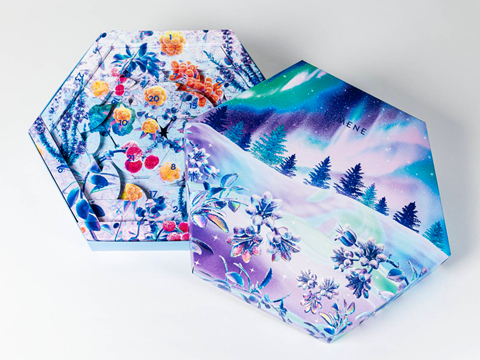
Lumene, Metsä Board, and Van Genechten have developed a ‘multi-dimensional’ advent calendar for cosmetic products, which is inspired by Nordic scenery and designed to be recycled in paperboard waste streams at end-of-life.
Designed collaboratively through virtual workshops, the calendar seeks to combine its inspirations from the Nordic landscape with ‘fresh and visually appealing elegance’ and result in a positive consumer experience.
It is made from MetsäBoard Prime FBB Bright and MetsäBoard Pro FBB Bright folding boxboards, which are themselves made from renewable wood fibres, according to Metsä Board. As such, it is said to be recyclable in the paperboard stream at end-of-life.
Meanwhile, the calendar itself consists of a ‘multi-dimensional structure’, from which a product can be removed every day in the lead up to Christmas.
“This year’s LUMENE cosmetics calendar has several dimensions,” explains Iiro Numminen, a packaging designer from Metsä Board’s packaging design team. “The innovative calendar part with product packages is hidden inside an outer package, which is closed by a separate sleeve. The concept forms a three-dimensional entity, both in terms of structure and graphics.
“The doors of the advent calendar are built from boxes of different shapes, which, when repeated, form a flower pattern. This innovative structure makes the interior particularly impressive, but also easy to manufacture.”
The boxboards are also said to provide a smooth surface and high brightness, which complement the pack’s graphic design, both on the calendar’s outer packaging and its protective sleeve. Both seek to capture the ‘northern spirit’ via domestic berries and winter scenery inspired by the Nordic region.
“The advent calendar is designed to create a visually stunning and immersive experience,” adds LUMENE’s Sustainability and Packaging director, Essi Arola. “The exterior captures the beauty of the northern landscape.
“The 3D embossing on the calendar’s surface adds a tactile feel to the illustration’s frozen flowers. The translucent holographic foil creates a magical sparkle, giving a festive, enchanting finish.”
A similar collaboration took place in 2022, when Metsä Board provided its dispersion-coated paperboard to help Fazer manufacture a lightweight, recyclable advent calendar. The solution was expected to cut down on 1200kg of plastic per year compared to the calendar’s previous design, which was coated with polyethylene.
The same year, STI Group released a series of fibre-based advent calendars for Unilever’s Dove and Axe brands. These included a ‘do-it-yourself’ option, in which consumers could build their own calendar with twenty-four mini gift bags; an ‘advent candle’ package containing four larger products, releasing a ‘lit’ flame design when a window is opened; and a non-Christmas alternative that consumers can utilize for gift-giving at any time of year.
Among the festive packaging for 2024 is a lineup of limited-edition packaging designs and personalized gift pouches for Nestlé’s confectionary products. These include a limited-edition Christmas cracker-shaped box for its Quality Street’s Coffee Creme flavour, and the option to refill pre-owned tins exclusively at John Lewis stores.
If you liked this story, you might also enjoy:
The ultimate guide to the Packaging and Packaging Waste Regulation in 2024
How are the top brands progressing on packaging sustainability?
Sustainable Innovation Report 2024: Current trends and future priorities
Everything you need to know about global plastic sustainability regulation











No comments yet